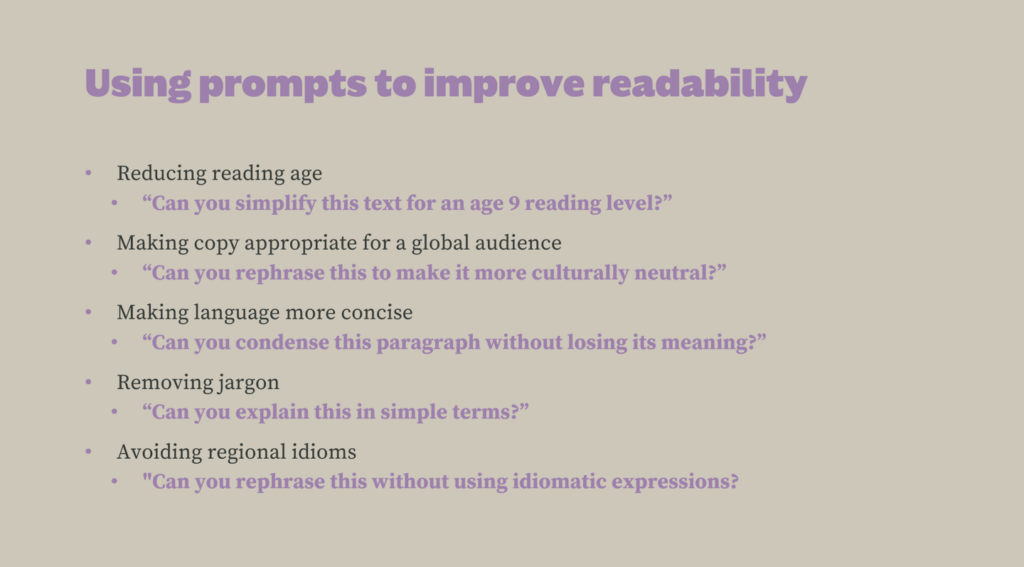Make more than a gesture this International Women’s Day
By Sally Pritchett
CEO
How can organisations celebrate International Women's Day in an authentic and meaningful way?
International Women’s Day (IWD) on 8 March has become a significant global occasion, recognised by both individuals and organisations around the world. IWD looks to celebrate the achievements of women, promote gender equity, and raise awareness about the challenges women face globally.
As International Women’s Day has grown, more people are looking for ways to show solidarity with women globally. But what is the best way for organisations to do this in an authentic and meaningful way?
For several years now, 8 March has been marked by a wave of people demonstrating their support for International Women’s Day through themed ‘gestures’. In 2020, supporters shared photos of themselves and their colleagues making equals signs with their arms to show they stood for equality. In 2022, they were encouraged to make a cross with their arms to ‘break the bias’ for women everywhere.
However, more recently the suggested ‘gestures’ for 2023 and 2024 have raised concerns. By asking people to share pictures of them hugging themselves or making heart shapes with their hands, organisations could be seen to be reinforcing gender stereotypes and diverting attention from the more serious issues at hand.

This year’s “Inspiring Inclusion” hand-heart pose may seem innocent, but it perpetuates the stereotype that women are defined by their emotional and nurturing qualities. This gesture reduces the rich diversity of women’s experiences and contributions, reinforcing traditional gender roles and going against the spirit of IWD.
How to celebrate International Women’s Day
By using the hand-heart gesture in International Women’s Day communications, you could inadvertently be doing more harm than good. But if this is the case, what are some alternative ways that organisations can celebrate women’s accomplishments in a meaningful way?
- Centre comms around the official UN IWD theme, Invest in women: Accelerate progress
- Shine the spotlight on female employee experiences through webinars, podcasts or panel discussions
- Amplify the voices of women in your business by inviting them to share their own stories
- Highlight any initiatives specifically designed to support women within the business
- Make public commitments to furthering gender equality in your organisation
- Provide educational content that helps audiences understand gender equality issues
- Partner with organisations that focus on women’s rights and empowerment
Need support creating impactful International Women’s Day communications? Let’s talk.
Want to see what we can do for you? Check out some of our work building inclusive cultures and celebrating diversity here.
Creating a more neuroinclusive work environment
By Sally Pritchett
CEO
With many citing empowering neurodivergent talent as a business imperative, discover how your workforce can behave in a more neuroinclusive way.
Embracing neurodiversity within your workforce can introduce fresh perspectives, new ways of thinking, and innovative ideas. According to Deloitte, “organizations that make an extra effort to recruit, retain, and nurture neurodivergent workers can gain a competitive edge from increased diversity in skills, ways of thinking, and approaches to problem-solving.”
With studies showing that an estimated 15-20% of adults are neurodivergent, businesses that neglect to take measures to recognise, embrace and support people who are neurodiverse, risk being left behind.
Neurodiversity isn’t a superpower. However, by empowering a diverse workforce, and creating a workplace environment where everyone feels understood and accepted, employees can feel psychologically safer and more able to share different perspectives and approaches.
There are some simple steps we can encourage employees to take to better support their neurodiverse colleagues.
So, what steps can we give our teams to help them work in a more neuroinclusive way?
In an office environment…
Reduce office overstimulation
Think about a typical office environment – bright lights, unexpected noises, different smells, lots of people moving around. This can make offices very overstimulating for many people. Consider ways you can help reduce office overstimulation. This could involve encouraging team members to take calls and eat their lunch away from the main office area, or to use headphones when watching videos.
Respect quiet spaces
If someone takes themselves away from a main office space to work it may be that they are looking for a quieter environment to focus. When someone seeks a quieter space to work, ask your team to consider popping over a quick message asking for a discussion or scheduling a dedicated time to talk.
When sharing information or tasks…
Give specific instructions
Don’t expect people to read between the lines. It can be very difficult for someone to pinpoint exactly what they need to do or achieve if they are not given specific instructions. Encourage clear and direct communication.
Avoid unclear information
We like the ‘What you need, by when, and why’ basis for giving them instructions , shared by Ellie Middleton in her highly recommended Nano Tips for Working Inclusively with Neurodivergent Employees LinkedIn Learning course. Saying things like ‘this is urgent’ but without clearer instructions can be overwhelming, as people’s perceptions of urgency can be different. Encourage your team to provide clear timeframes to help colleagues plan their time accordingly or rearrange tasks if needed.
Keep everyone on the same page
Have all processes and policies written down so that everyone has access to clear guidelines. Ensure that everyone knows where and how to access these processes and policies so they can refer to them as they need to.
Make information available
Neurodivergent people can become overwhelmed by not having enough information. Make sure all the details people could need in the workplace or for specific tasks are accessible. It can also help to provide people with the opportunity to ask for further information if they require it.
When working together…
Adapt communication styles
We all communicate with one another in different ways, and some people feel more confident expressing themselves through specific methods of communication. Encourage your team to tune in to and understand each other’s preferred ways of communicating, and adapt to these styles where possible. For example, when asking for ideas or feedback in a meeting, you could also give people an opportunity to share their thoughts via email after the discussion.
Embrace diverse work styles
It’s important to recognise and appreciate that people have varied work rhythms. By focusing on outcomes, instead of the way someone reaches that outcome, people can feel more comfortable working in a way that helps them deliver their best work.
Share information early
Help everyone prepare by always sharing meeting agendas and information in advance. This gives people a chance to digest the information they need to understand and feel comfortable and confident when they get into a meeting.
Pop over a message before calls
Unexpected calls or meetings can disrupt people or cause them to feel unprepared for or anxious about the incoming call. Suggest that colleagues send a quick message before making calls to help ensure a productive conversation, and give people time to prepare for and get into the right mindset for the call.
Neuroinclusion benefits everyone
As we’ve discussed, diversity brings new perspectives and ways of thinking about things. Better support of neurodivergent people can help us all to access different perspectives and approaches. A neuroinclusive environment nurtures a culture of empathy and acceptance, enhancing the workplace and strengthening teamwork.
However, reading through these tips you may have felt that they are really just some best practice and sensible suggestions on ways of working with other people. Neuroinclusive practices foster clearer communication, patience, and understanding among all team members – both neurodivergent and neurotypical. An inclusive approach paves the way for better interactions and collaboration, benefiting everyone.
Are you ready to talk about neuroinclusion?
If you want to start the conversation about neuroinclusive working with your employees, get in touch as we can support you with creating engaging communications that help nurture an inclusive workplace culture.
Q2 2024 Awareness Days Calendar
By Sally Pritchett
CEO
Download your free Awareness Days Calendar for Q2 2024.
Don’t miss an important date in the second quarter of the year with our downloadable calendar that includes key employee wellbeing, sustainability and environmental, and diversity and inclusion awareness days.
These are all important topics that should be high on the agenda for every business. Our Q2 2024 Awareness Days Calendar can help you:
- Plan your employee wellbeing programmes.
- Raise the profile of your sustainability activities.
- Keep your diversity and inclusion engagement programmes on track.
- Effectively engage your employees with important conversations.
- Recognise events that are important to colleagues and customers.
If you’re looking for support to make the most of these opportunities, get in touch to see how we can help.
Download our Key Awareness Days Calendar for Q2 2024
5 trends that we expect will shape workplace culture in 2024
By Sally Pritchett
CEO
Curious about the evolving workplace culture in 2024? Explore these five key employee priorities.
Workplace culture has a profound impact on employee engagement, productivity, and morale, so organisations must keep up with what is important to employees to help nurture a positive environment. With 45% of UK employees saying a great culture is the most important factor when looking for a new job, what should employers be looking out for in 2024?
1. Flexibility will continue to be key
The pandemic changed the way many of us work, driving a surge in the number of employees working from home. In 2023, some companies continued with fully remote working, whereas others have started to implement return-to-office policies and hybrid work options. But what could happen in 2024?
We expect to see more of a shift towards employees wanting flexibility, rather than just the opportunity to work from home. With 71% of workers saying a flexible working pattern is important to them when considering a new role, this suggests employees are looking for flexibility around arrangements such as start and finish times or where they work from too, to help them achieve a better work-life balance.
2. Prioritising employee mental health and wellbeing
We believe nurturing a healthy culture that supports employee mental health and wellbeing is one of the biggest areas of importance for 2024. In 2020-2021 alone, .
Although the effect of not prioritising employee wellbeing on productivity is clear, nurturing a healthy workplace culture is about much more than just the financial impact. In a workplace where wellbeing is prioritised, there is likely to be higher employee morale, reduced turnover, and increased job satisfaction.
3. The demand for sustainability
With Gen Z joining the workforce, they are beginning to influence workplace culture. By 2025, Gen Z will account for 27% of the workforce, so employers will need to start listening to what’s important to them if they wish to attract and retain the next generation of talent.
With 50% of Gen Zs saying they are pushing their employer to drive change on environmental issues, it’s clear that sustainability is an important matter that employers need to prioritise as part of their workplace culture initiatives. However, as well as businesses looking at organisational sustainability initiatives, part of building an environmentally conscious workplace culture involves supporting and empowering employees to make better choices in their lives outside of work.
4. Employees want to feel a sense of belonging
This year, diversity, equity and inclusion have become increasingly important in the workplace. In 2024, the focus on DEIB is set to continue. 65% of employees admit they want to feel a strong sense of belonging at work, suggesting employers need to start going further than just having a DEIB policy.
Many employees now want to feel like part of a community at work, form stronger connections with colleagues, and feel like they can be their true selves at work. To help nurture this type of culture, employers need to ensure their DEIB initiatives are accessible, thorough, and most importantly, authentic.
5. The importance of internal communications
Internal communications help keep employees informed, engaged and connected to a business. However, effective internal communications are about more than just sending out a monthly email newsletter to employees. There are many channels that employers can, and should, use to keep employees engaged with the business. This is particularly important for reaching frontline workers, where email isn’t necessarily the best way to communicate with the workforce.
As we approach 2024, nurturing a healthy, safe and thriving workplace culture has never been more important. If you’re looking for some support in developing internal communications strategies or initiatives that engage your workforce, we’re here to help.
Navigating AI Together: Making AI an ally to inclusive communications
By Sally Pritchett
CEO
How can we tackle AI bias for more inclusive and authentic representation?
At our recent ‘Navigating AI Together’ roundtable, we delved into the critical issue of biases within AI and how we can look to overcome the in-built bias and use AI as a tool to foster inclusion and authentic representation.
We were delighted to welcome Ali Fisher, a seasoned expert in fostering sustainable, diverse, equitable, and purpose-driven business practices. With a background including leadership at Unilever and the Dove Self-Esteem Project, Ali brought a wealth of knowledge and experience in the realm of DE&I. Her invaluable insights provided fresh perspectives on navigating AI’s impact on communications.
Unravelling bias in AI
Generative AI offers amazing opportunities for communicators, but its power comes with a challenge: inherent biases. Generative AI has been trained on human-created content, and so has inherited deep-seated bias built in. This bias can, and often does, unintentionally permeate AI-generated content, reinforcing stereotypes and misconceptions.
It’s been well documented and discussed over the last year that generative AI takes bias and stereotyping from bad to worse – with Bloomberg publishing headlines like ‘Humans are biased, generative AI is even worse’. This bias is of course very worrying when we’re also seeing reports that 73% of users globally already say they trust content created by generative AI.
But let’s go back a step. While generative AI may be biased due to the training data that feeds it, what about the conditions under which the AI tools themselves are developed?
The lack of diversity within the tech industry adds complexity. The gender disparity is evident, with only 22% of the UK tech sector and 21% of US computer science degree earners being women. One study showed that code written by women was approved the first time round more often than men’s, but only if the gender of the coder was hidden. If the gender was revealed, the data showed that women coders received 35% more rejections of their code than men.
Race and ethnicity disparities in tech are also concerning. Looking at the US and a report from the McKinsey Institute of Black Economic Mobility, Black people make up 12% of the US workforce but only 8% of employees in tech jobs. That percentage is even smaller further up the corporate ladder, with just 3% of tech executives in the C-suite being Black. It’s believed that the gap will likely widen over the next decade.
Nurturing AI as responsible guides
During our ‘Navigating AI together’ roundtable, an analogy was shared: AI is like a toddler trying to cross a busy road. Like how we wouldn’t allow a toddler to wander into traffic alone, we must hold the hand of AI and safely guide it.
We need to understand the EDI landscape thoroughly first, becoming adept guides before we can expect AI to generate outputs that are genuinely inclusive and authentically representative. As humans, we need to be responsible AI users, always giving a guiding hand. The first step to making AI an ally to inclusive communications is self-reflection.
Navigating our human bias
We’re human, and we’re fallible, and it is important to remember that in the context of EDI.
In one study, researchers observed 9-month-old babies, evenly divided between Black and white infants. They were all equally exposed to both Black and white adults, all unknown to them. The white babies consistently gravitated toward the white adults, while the Black infants showed a preference for the Black adults. This inclination toward familiarity emerged as early as nine months, suggesting an inherent comfort with those we perceive as similar.
As humans, we tend to categorise. We employ schemas and, yes, stereotypes as well. It’s a coping mechanism and our brain’s attempt to simplify the barrage of information we encounter daily. Yet, this simplification comes with a call for heightened awareness. We need to consciously slow down, be vigilant and actively recognize these tendencies within ourselves.
Increasing awareness of our unconscious biases
Unconscious bias refers to the automatic attitudes and stereotypes that influence our judgments and actions without our conscious awareness. Shaped by our experiences and societal influences, these biases impact how we view others.
If you’re considering using AI within your communications, then you must understand what your own unconscious biases are. The Harvard IATs – Implicit Association Tests – are a useful tool to help you begin to do this. Set up by a collaboration of US researchers in 1998 Project Implicit aims to collect data on our biases as we learn about ourselves. We’d recommended picking one identity characteristic you think you don’t carry bias on and one you think you do – and see how it plays out.
Exploring bias in generative AI
Moving on from understanding why generative AI contains bias and recognising how our biases influence our perceptions, let’s shift our focus to examining the actual AI outputs. You likely have already encountered biased outputs from AI, but in our session, we made several comparisons between the results of Google’s image search results algorithm and the outputs from generative AI tools ChatGPT and Midjourney.
Let’s start with a familiar scenario: the image of a courier. When you think of a courier – the person who delivers your Amazon packages – what’s the immediate mental picture that springs to mind?
A quick Google image search result shows a courier as a man carrying a box, often with a van. This representation is the outcome of the content humans have uploaded – it’s not a product of machine learning.
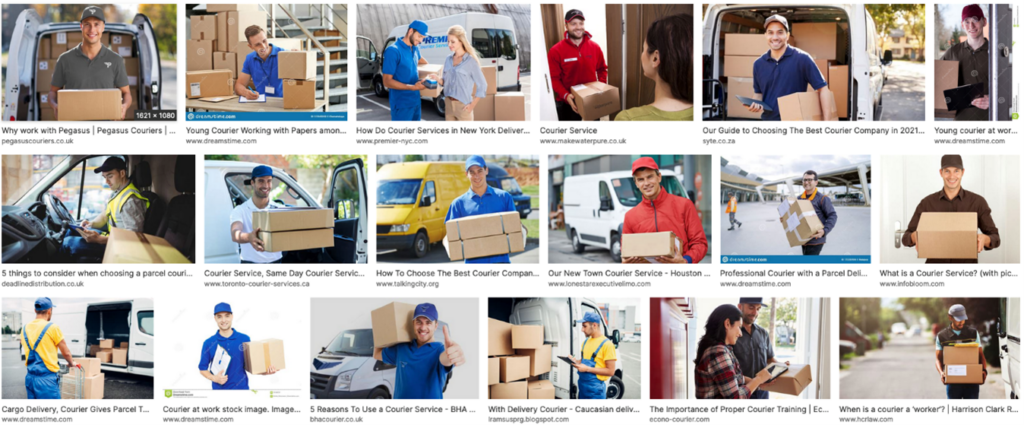
Now, let’s compare it to what AI, drawing from its training data, perceives as a courier’s life.
When we prompted ChatGPT to describe a day in the life of a courier, it conjured a narrative around a character named Jake.
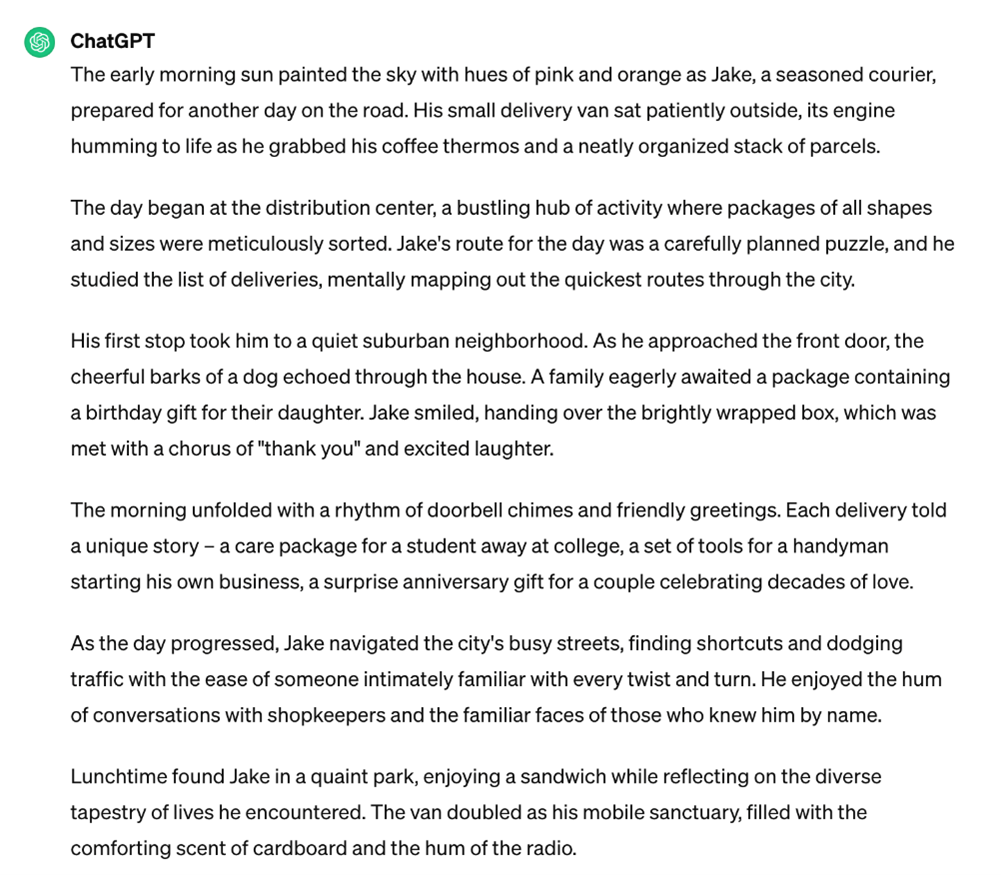
Similarly, looking at Midjourney’s output, we have images suggesting men with boxes and motorbikes as representations of couriers.

Over the course of the roundtable, we shared and discussed many examples showing the bias of AI. To get a better understanding of this, we recommended watching Amy Web’s presentation at the Nordic Business Forum. Amy revealed how AI mirrors human biases. From CEOs to tampons, AI struggled.
It’s safe to say that AI does not challenge the perception of who a person could be. It often reflects society’s most ingrained stereotypes at us and fails to accurately reflect a range of EDI characteristics that humans have.
AI and authentic representation
There are only four EDI identity characteristics that we see or perceive easily – tone of voice, mannerisms, attire, and skin colour. Everything else requires more information from the individual. We can’t accurately assume someone’s age, gender, sexual orientation, race or ethnicity. We can’t assume whether someone has a disability or not.
So how does AI fare when it comes to navigating these visible and invisible EDI characteristics?
If you ask Midjourney to show you construction workers, you’ll likely get something like this, with a clear lack of visible diversity among the four images.

We then asked Midjourney to depict construction workers with a disability. The generated images were all very similar, with three of the four depicting the construction worker as a wheelchair user.
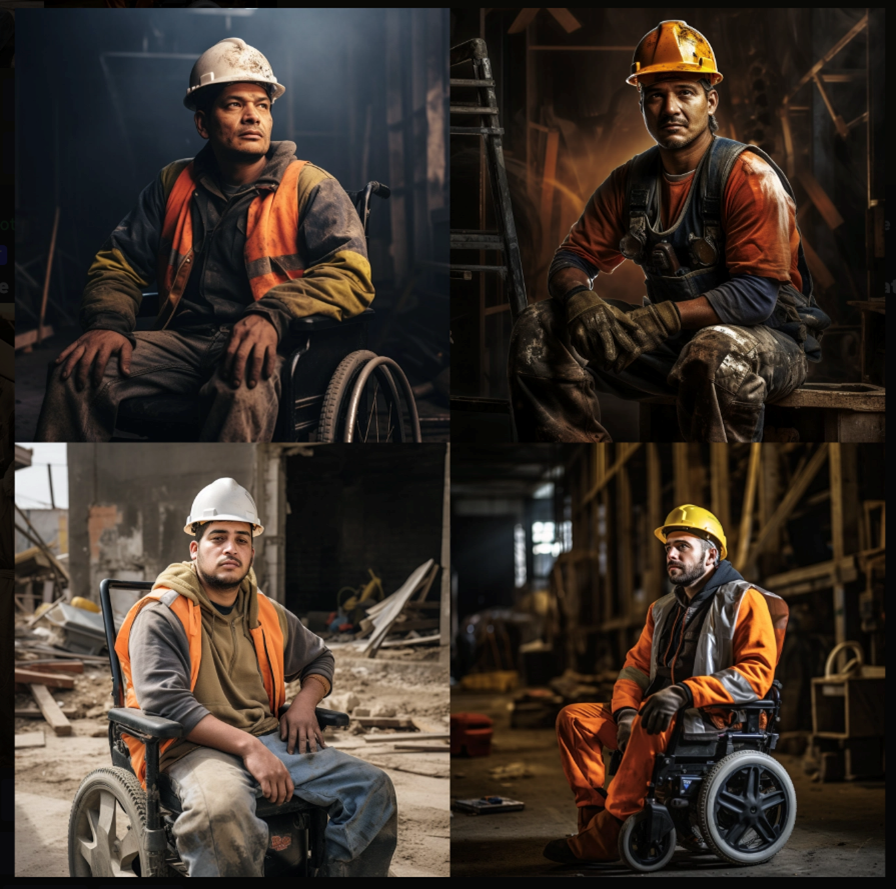
We then asked Midjourney to depict LGBTQIA+ construction workers. This output really shows the propensity of AI to stereotype.

When it comes to minority groups, AI seems to at best lean on lazy stereotypes, and at worst create an offensive parody of reality. These results show how important it is for us to be hyper-aware of EDI within our communications when using AI, and to hold the hand of that toddler crossing the road tightly!
How to make AI an ally to inclusive communications
As the human communicators guiding the hand of AI, reducing our personal bias has to be the first step:
- Engage in the Harvard IATs to heighten awareness of your unconscious biases
- Be prepared to get it wrong and learn from your mistakes
- Evaluate the diversity in your social and professional circle
- Challenge yourself to culture-add, not culture-fit
- Practice active listening, valuing others’ perspectives over your own voice
With that foundation in place, our top tips for reducing AI bias are:
- Craft prompts carefully to guide unbiased outcomes
- Offer contextual details for to help AI better understand your expectations and requirements
- Fact check for genuine and authentic representation in all AI-generated content
- Offer corrective feedback to steer AI responses towards inclusivity
- Develop ethical guidelines for all AI users and undertake through training
Reach out to us or Ali for a deeper conversation on how you can cultivate a culture that embraces and understands the value of DEIB within your organisation.
To join our upcoming ‘Navigating AI Together’ session in 2024, please send an email over to hello@somethingbig.co.uk to stay in the loop.
Five AI trends we expect to see in 2024
By Sally Pritchett
CEO
Looking ahead to 2024, what AI trends can we anticipate?
This year, we have witnessed the rapid growth of AI. New platforms, applications, and software have emerged for almost every industry, including creative communications. However, in the ever-evolving landscape of AI, what trends can we expect to see in 2024?
Increased legislation
Nations across the globe are forming comprehensive AI policies in order to set regulations, drive innovative growth, and help ensure everyone can benefit from AI. As AI continues to advance, expect to see further guidelines and regulations introduced, including laws to prevent harmful content such as deepfakes. The speed at which AI evolves is set to continue in 2024, so we expect legislation will continually evolve to keep up with this new technology.
The importance of ethical AI
As AI becomes more widely adopted in 2024, we will see a continued focus on it being developed and used in a responsible way. There are already concerns about AI biases, plagiarism, accuracy, and a lack of transparency. However, despite these concerns, 73% of users trust content created by generative AI. This worrying statistic highlights how important it is that AI is used ethically. As we head into 2024, experts expect to see an increased interest in AI ethics education.
In the communications industry, honesty, accuracy and inclusivity are vital, so it’s important that we use AI in a responsible way. We believe it’s time for the communications industry to take the lead and set its own guidelines for ethical AI usage.
AI-enhanced creativity
AI is rapidly becoming a collaborative partner to people in many different job roles across a vast range of industries, including creative communications. Platforms such as Midjourney and Adobe Firefly have brought AI capabilities to the creative industry with tools such as generative fill. Whilst there is no replacement for human creativity, these tools can help creatives work more efficiently. As we move through 2024, expect to see these tools more widely adopted and new capabilities introduced.
The next generation of generative AI
Generative AI has advanced rapidly this past year, and the pace is set to continue. In 2024, generative AI is expected to advance further, from language model-based chatbots such as ChatGPT to video creation tools. Experts predict that AI applications and tools will become more powerful and user-friendly, new applications and capabilities will appear, and the difference between human and AI-generated content will become trickier to determine. Furthermore, we will start to see AI integrated into commonly used applications, such as the introduction of Microsoft 365 Copilot across the Microsoft 365 product suite.
AI as an intelligent assistant
As AI continues to be integrated into more commonly used applications and software, it is expected that it will start to become an intelligent assistant to us in our everyday work. From summarising lengthy PDF documents to grammar checking, and highlighting social media trends to researching hot topics, AI can help us work more efficiently. However, while AI offers opportunities to streamline processes and increase efficiency, we must still ensure responsible and ethical use.
Navigating AI together: overcoming bias and achieving inclusion
With the AI revolution upon us, we’ve been facilitating regular roundtable discussions to support communicators in navigating this change together.

In our next session we will examine the issue of the biases embedded in AI and explore how we can mitigate this bias and harness AI tools to foster greater inclusion and authentic representation.
Let’s continue Navigating AI Together, ensuring responsible, ethical, and inclusive AI usage in our communication practices.
Sustainable production: tips for greener communications in 2024
By Sally Pritchett
CEO
Get insights and actionable tips on sustainable production for greener communications in 2024.
Reading anything about climate change can make us feel helpless and overwhelmed by the size of the challenges, but as a B Corp we believe in continuous progress and action over words. We’re delighted to share some of our learnings and tips to help others make everyday swaps and changes in the right direction.
Sustainable production purchasing
Here are three easy ways you can pledge to make your communications production more sustainable:
Choosing sustainable paper
To reach your audience and communicate in a way that is best for them, sometimes you need to print. If you make the right printing choices, the often-held belief that digital communications are greener than print isn’t always true. Where possible insist on FSC or PEFC-accredited paper sources, this means that production has supported responsible forest management, prevents illegal logging and protects wildlife and local communities.
Go local, where you can
When possible, try to reduce the air miles of your communications by insisting on local production. This may increase prices on some lower-quality products, but it can also come with the benefits of faster turnaround times, avoiding long shipping times.
Switch to B Corp or accredited sustainable suppliers
Whether it’s B Corp, Planet Mark, or ISO 14001, there are many verified accreditations that organisations can go through to prove their commitment to sustainability. Try to fill your supply chain with organisations who are committed to making a difference and taking sustainability seriously.
Responsible production and consumption
Here are three straightforward strategies to minimize your communications consumption while prioritising sustainable production practices.
Look after your stock
It’s common for boxes of promotional giveaways to be sent off to events and never return, leading to avoidable waste. Plan ahead and establish a process to facilitate easy returns. This ensures that unused items come back into stock safely, ready to be reused for future events. If you’re managing a store of items, make a point of knowing what goes in and out so that you can protect stock and only re-order when needed. It’s useful to share the value of items with your stakeholders so they can better understand the budget impact of wastage.
Make your giveaways practical and useful
Make sure that promotional items are as useful, practical, and long-lasting as possible to prevent further wastage. Hopefully long gone are the days of frivolous gimmicky single-use giveaways. A simple way to check is to ask yourself ‘Would I use this?’ or ‘How long would I keep this?’.
Think differently about how you give things away
We’re all used to event goody bags and placing giveaways on chairs or at every table setting, but this can contribute to unnecessary waste. Attendees often leave items behind, which may end up in the bin or linger at the bottom of bags, eventually being discarded at home. Let’s commit to a different approach by offering attendees the option to choose whether they want to take the giveaway.
Try having a ‘goodbye’ table where people can choose what they’d like to take. This reduces the waste and makes attendees value the items they pick up more. You could also try gamifying giveaways, making attendees work to earn the ‘merch’ and in doing so increasing their connection with it.
If you automatically send items out to data lists, commit to reviewing your data more often to make sure you’re not sending items to out-of-date contacts.
Promotional merchandise can play a great role in building loyalty and has longevity in comparison to many other techniques, so it can’t always be something to avoid altogether but if you’re still producing single-use, plastic pens then it’s time to rethink your approach to branded merchandise.
Sustainable production swaps
Here are three sustainable replacement items you might be able to introduce into your 2024 communications plans to reduce less sustainable alternatives:
Notepads made with apple peel covers
Crafted from apple peel, vegetable fibers, and sustainable pulp, these Appeel notebooks feature FSC-certified ivory-tinted apple paper, providing a personalised touch.
Notepads made from stone
Opt for stone paper notepads for a 100% tree-free and water-resistant alternative, saving water in the production process.
Compostable pencils with seeds
Personalised pencils made from sustainably harvested wood offer a lead-free, graphite core. After use, these pencils can be planted to grow into various plants, adding a touch of sustainability to your giveaways.
We know how tricky it can be to align promo and print with your commitment to sustainability. Let us guide you to making more environmentally responsible choices.
Attract and retain top talent: the power of purpose and culture
By Sally Pritchett
CEO
When culture, honest communication, and purpose are essential, how can communicators attract and retain top talent?
Ever find yourself lost in the hustle, wondering where all your time goes? The busier life gets, the more crucial it becomes to reflect on how we spend our time. After all, time is precious, and optimising it is an art.
In a video earlier this year, our Commercial Director reflected on the time they had devoted to a battle they know all too well – the Talent War. To be exact, 650+ hours in 2022 alone, navigating the competitive landscape of recruitment, CVs, interviews, and the rollercoaster of onboarding and, unfortunately, occasional offboarding.
While some say the Talent War is over due to economic instability, the truth is that many employees are still seeking purpose in their work. Moreover, the growing differences in generational expectations regarding the workplace is creating challenges in attracting, and retaining, top talent. These shifts show that finding and keeping top talent goes beyond just economic factors.
When workplace culture, honest communications, and company purpose are vital to today’s employees, what can communicators do to attract and retain top talent?
Engage with hearts and minds
Attracting talent boils down to one thing: opening and engaging with the hearts and minds of potential candidates. Let’s take a trip back to 2001 when Apple revolutionised the music industry with the iPod. What set it apart wasn’t specs and features but the simplicity and clarity of its message – “1,000 songs in your pocket.” In today’s competitive job market, what’s your unique selling proposition? Flexible working, competitive salaries, and employee benefits while all essential to many job seekers, don’t define a company in the long run.
The power of purpose
The key to success? Define what sets your company apart, and that comes down to your company’s purpose. Employee motivations are evolving, and companies addressing this shift are few and far between. People crave purpose in their work. Statistics show 75% of the workforce will be ethically-minded millennials by 2025. Placing purpose front and centre, and integrating it into job descriptions and candidate discussions can help you connect with the right candidates and sidestep those where synergy is lacking.
Building a magnetic culture
It costs to attract, engage, and grow your people. The solution? Building a magnetic culture. A business with a magnetic culture draws people in, creates unity, and retains the best talent. And a thriving culture boosts productivity, improves customer service, and reduces turnover costs. In retention, go beyond the basics.
Be like Apple – stand apart. Focus on creating a thriving culture, driven by your purpose, to make your business different.
Whether you’re refreshing your recruitment communications or nurturing a united workplace culture, we can provide the support you need.
Navigating AI Together: Accessibility, transparency and voice cloning
By Sally Pritchett
CEO
We're uniting communicators to navigate the ever-evolving AI landscape. Here, we share insights from our most recent 'Navigating AI Together' roundtable.
AI can be a scary topic. For many the opportunity for a big productivity boost is sitting alongside fears around role replacement and the devaluing of skills. When we heard these concerns from fellow communicators, we knew we needed to help. Our ‘Navigating AI Together’ forum is supporting communicators to manage the transition to AI together, safely, ethically, and with positive and open mindsets.
In our most recent session of Navigating AI Together, we delved into the current state of AI, strategies for enhancing communication accessibility and inclusivity, the importance of AI transparency, and even took a deep dive into the fascinating realm of AI voice cloning.
In previous sessions we have:
- Explored the role AI in communications, including the challenges and opportunities.
- Shared a guide to prompting, tailored to communication professionals.
- Discussed the creation of policies for responsible AI usage and user accountability.
- Provided a review of Midjourney.
- Examined AI-assisted video creation.
The current state of AI
In the latest ‘Navigating AI together’ session we reflected on the rapid growth of AI, especially with the recent emergence of generative AI, symbolised by ChatGPT’s meteoric rise. With the genie now out of the bottle, the AI landscape is evolving exponentially, leading to an influx of uses, applications, and platforms. However, experts are suggesting that we may not experience another technological leap of this magnitude anytime soon. Our collective responsibility is now to maximize AI’s potential while adhering to clear usage guidelines and responsible practices.
Notably, a concerning statistic has emerged, revealing that 73% of users trust content generated by generative AI. This really shows the importance of close supervision in AI-generated content, especially in the communication field, where reliability and truthfulness are paramount.
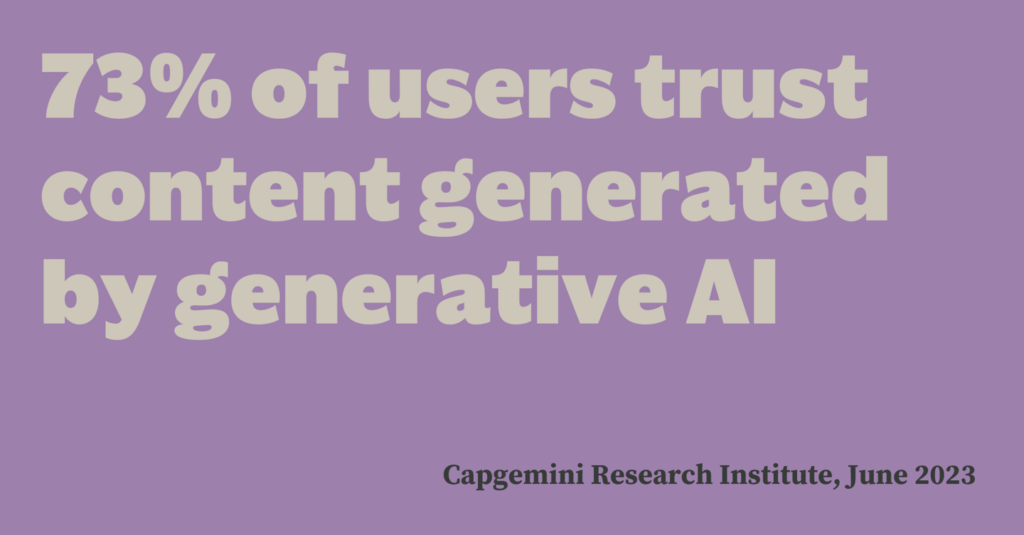
As for legislation and regulation, while it may be in development, progress will be slow and may not fully address the intricacies of AI usage. We believe that it’s time for the communications industry to take the lead in setting its own guidelines for AI usage.
However, despite all the disruption, there is a positive note. AI is already making a substantial positive impact in various domains, from improving cancer screening to addressing climate change, conserving wildlife, and fighting world hunger. The potential for AI to do good is vast and exciting.
How AI can enhance communication accessibility
Our role as communication professionals includes making our communication as effective as possible and ensuring it is accessible to everyone. Currently, fewer than 4% of the world’s top million websites are accessible to people with disabilities. AI can help accelerate progress in this regard by simplifying and enhancing communication:
- Copy simplification with AI editors – Tools like Hemmingway can simplify and improve readability, making communication more accessible.
- AI prompts for readability – Using AI prompts to tailor text for different reading levels, cultures, and languages.
- Digital signing – New platforms in development, like Signapse, will be able to create sign language from text or audio, making communication accessible to people who use sign language.
- Translation – AI can help level up and speed up translation, providing accurate and natural translation, learning from feedback over time.
- Image descriptors – Tools like Verbit can create audio descriptions of images in real-time.
- Text to Speech / Speech to Text – Enhances accessibility for various communication modes.
- Multi-Lingual Chatbots – Assist in multilingual communication.
The importance of AI transparency
During the forum we addressed the significant issue of transparency in AI. We posed thought-provoking questions to the group about transparency and shared considerations for when, how, and whether to be transparent in our AI usage. Our conversations showed that transparency in AI isn’t a straightforward, black-and-white matter; rather, it exists on a spectrum with shades of grey. Determining when to be transparent about our use of AI can pose significant challenges.
Regulation has already driven the need for transparency in various digital domains, such as cookies on websites and advertisements in social media. Just as privacy regulations have mandated the disclosure of cookie usage, AI may could follow a similar path. Users may come to expect clear information about when AI is involved in content generation, and it may be time for communicators to rise to this challenge without the need for legislation.
AI voice cloning
Voice cloning tools use AI and deep learning algorithms to replicate and mimic human voices. These tools analyse the vocal characteristics, pitch, tone, and nuances of a person’s voice from a sample of audio recordings. Once trained, they can generate speech that closely resembles the original speaker’s voice, allowing for the creation of natural-sounding, synthetic voices.
AI voice cloning has numerous applications, from creating realistic voice assistants to generating voiceovers for content. However, it also raises ethical concerns about potential misuse and impersonation, highlighting the need for responsible use and regulation in this rapidly advancing field.
We investigated several voice cloning tools and shared our findings with the group’s attendees. If you’d like to find out more then please reach out.
Navigating AI together: overcoming bias and achieving inclusion
In our next session we will examine the issue of the biases embedded in AI and explore how we can mitigate this bias and harness AI tools to foster greater inclusion and authentic representation.
Let’s continue Navigating AI Together, ensuring responsible, ethical, and inclusive AI usage in our communication practices.
What is the role of communicators in attracting women to male-dominated industries?
By Sally Pritchett
CEO
When one gender clearly dominates a business or sector, it means a loss of valuable skills, perspectives, and ideas. So, what can communicators do to promote gender diversity?
At Something Big, we have lots of experience working within industries that are typically male-dominated, like logistics, engineering, construction, finance and tech. To start a dialogue and share insights across businesses and sectors we brought together HR, Diversity, and Internal Comms leaders for a meaningful discussion on how to attract women into traditionally male-dominated sectors and drive a better gender balance. In this article, we’ll share the insights gathered and the actionable takeaways you can use to enrich your DEI toolkit.
Are we bridging the gender gap?
There are many industries that are male or female-dominated. For example, within the construction industry, 15% of the workforce is female, with just 2% of on-site workers being female. In contrast, some industries are predominately female, with just 2.22% of nursery nurses and assistants being male. A quick glance at the statistics reveals a stark gender imbalance across various sectors.
But the big question is, are we making any progress in this area? When looking at early careers, internships, and apprenticeships, a report by the Young Women’s Trust showed that in key sectors such as engineering, men outnumber women 25 to one. This glaring inequality emphasises the need for change.
What can communicators do to attract women to male-dominated industries?
During our discussion, we identified multiple ways that communicators can drive change and address gender imbalance in the workplace.
During the recruitment process:
- Ensure that gender-biased language is removed from job ads. You can use AI tools or dedicated gendered language decoders to help you identify any subtle bias in job ads.
- Simplify technical jargon in job descriptions to better welcome new people to your industry.
- Listen to the experiences of women within your business to find out why they like working there and use that insight to understand what could attract new employees.
- Use diverse advertising channels to reach new audiences. Within our discussion group, both Mosques and school newsletters were identified as channels for reaching new audiences.
- Have diverse and inclusive imagery in your recruitment materials, while ensuring your photography is representative of your workplace and culture.
Within workplace culture:
- Recognise that the workplace can still be a challenging environment for women. 61% of Gen Z’s and 49% of Millennials believe they’ve been harassed in the workplace in the last 12 months, including physical advances, inappropriate emails, exclusion and gender-based undermining.
- Implement safe avenues for employees to speak up and seek help about any negative experiences.
- Develop a culture of allyship and consider training all team members on the 5Ds of active bystander intervention – Distract, Delegate, Document, Delay, and Direct.
- Consider the language that is used within your business. It’s common to hear things like ‘working mums’ and ‘women in business’, and often these are meant in a well-meaning way, but we never hear about ‘working dads’ or ‘men in business’.
- Properly fund, support and empower employee resource groups (ERGs) to ensure your employees have a voice. This will enable you to get to the crux of what’s working, and what’s not.
Employee communications:
- Avoid empty communications or empty promises by ensuring your communications align with your actions. Employees are quick to spot inconsistencies, and empty promises can lead to a loss of trust.
- Effective communication is not one-size-fits-all. Tailor your messages to reach employees at the right time with the right information. Avoid sending blanket messages that may make it difficult for employees to access the specific information they need.
Policies and processes:
- Scrutinize your policies and processes to identify any unnecessary barriers that hinder the hiring and retention of female talent. An example shared during our discussions was a company writing into the contract of an autistic worker that they did not need to answer the phone, making the role accessible without affecting performance.
- In the UK, men spend about 16 hours a week on unpaid tasks like taking care of children and cleaning, whereas women dedicate 26 hours a week to these responsibilities. Businesses could consider revising some policies to better support men and women in achieving a work-life balance. For example, in Norway fathers are entitled to 15 weeks of non-transferable parental leave, designed to foster a more equal split of childcare responsibilities. Whilst this might not be the regulations within your country, that doesn’t mean organisations can’t support changes like this.
Leading the charge in attracting women to male-dominated industries
In the journey toward creating more gender-diverse workplaces, it’s essential to acknowledge and support the organisations and individuals who are already pioneering change. Here are some organisations that may be relevant to your sector:
- Women in Logistics
- Women into Construction
- Women in Tech
- Women’s Engineering Society
- Women in Fire Services
- British Association for Women in Policing
- Lean In Circles – Women in Finance
As a final point within our discussion group, we underscored the advantages of cultivating a growth mindset and exchanged recommendations for three insightful books to help develop our thinking and understanding: “Lift as I Climb,” “Invisible Women,” and “Lean In.”
By adopting clear communication, shifting cultural norms, and embracing a diverse and inclusive workplace, businesses can create environments that support all employees. This not only fosters gender diversity but also contributes to a more inclusive, caring, and productive work environment for everyone.
If you’re looking for a partner agency to help make your workplace fairer, healthier and happier, then we’d love to hear from you.










